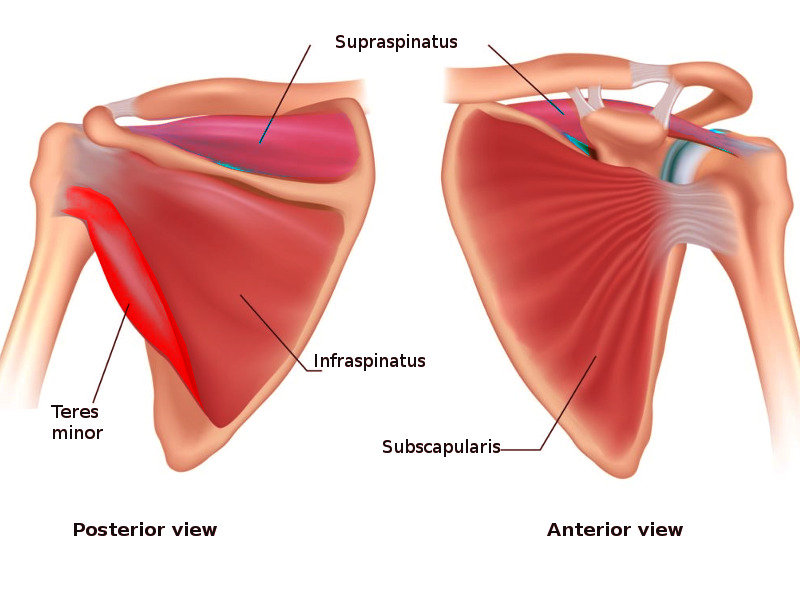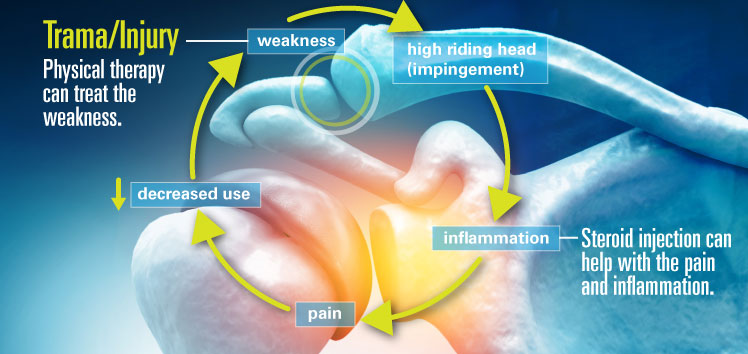Why the heck does my shoulder hurt so much?
Shoulder pain comes in all shapes and sizes and at all times of life most commonly in our teenage years and into our 20s and then again between ages 40 and 60. As we age arthritis can set in and this brings on a whole different level and type of shoulder pain. The focus of this blog will be rotator cuff injuries and how that fits into the grand scheme of things.
What the heck is a rotator cuff?
A rotator cuff is a complex set of muscles and tendons that originates on the shoulder blade and reaches out to cover the ball of your shoulder. There are a total of four rotator cuff muscles and each one pulls the shoulder in a different direction either internally or externally rotating the shoulder and provides for help in elevating the shoulder. The rotator cuff also serves as a buffer of sorts and I’ll explain this later. In addition, the net effect of the rotator cuff is to keep the ball of the ball and socket in a stable position pressed up against the socket so as not to prevent high riding of the shoulder. Now that was a mouthful. Let’s break that down into smaller bites.
The muscles of the rotator cuff
When you look at the diagram on the right you will see a model of a shoulder. In this model you will see muscles that are labeled.
These are the four muscles of the rotator cuff. I have drawn arrows to show how the rotator cuff pulls the ball into the socket to help stabilize it. Once the muscles have stabilized the rotator cuff the shoulder can then move by using the bigger muscles such as the pectoralis and the deltoid and the latissimus dorsi.
How does it all go wrong?
Either through an acute injury, overuse or degeneration over time, swelling occurs in the space between the rotator cuff in the roof of the shoulder. The roof of the shoulder is an extension off of the scapula or shoulder blade and this is called the acromion. A normal space between the roof of the shoulder and the acromion is less than 8 millimeters. This is about a little more than ¼ of an inch. Anything that causes swelling in that space creates tightness and what we call impingement. This has also been referred to as Bursitis. When impingement occurs, it hurts. When the shoulder hurts the rotator cuff it gets weak because of lack of use and because of lack of use the ball is less stabilized within the socket and starts to ride high causing more impingement more swelling and more pain and thus a vicious cycle ensues. See figure 2.
 Figure 2
Figure 2
So, what do rotator cuff problems feel like
Many patients with rotator cuff issues will complain of a dull achy pain that starts in the shoulder and goes towards the outside of their arm directly over the deltoid muscle. This pain is often present all of the time or it is made worse with attempts at raising the arm or performing any sort of lifting activity with the arm in a straight position. The pain is often enough to keep a patient awake at night or to wake them from sleep when they roll on that shoulder. Sometimes it is only in very specific positions of the shoulder where it hurts. Most often there is some associated weakness when the shoulder is used with the hand over the patient’s head.
What the heck can I do to fix this pain
Treatment for rotator cuff disease is dependent on the nature and cause of the disease in the first place. For instance, in a patient who is young and active who had a slip and fall or other traumatic injury and sustained a tear in their rotator cuff surgery is most often the best first choice. However, as we age the same injuries can often be successfully treated with a combination of physical therapy and maybe cortisone injections. If you’ve had an injury and can’t raise your arm anymore it’s imperative that you see in orthopedic surgeon as soon as possible so that they can help you decide what is best for your shoulder. Long standing rotator cuff tears can be very challenging to treat, and this highlights the need for early management by a skilled professional in orthopedics.
Injuries to the shoulder and pain that have been longstanding can often be treated with directed physical therapy and sometimes cortisone injections. This sort of shoulder issue is the most common. Nonoperative management is successful at least 80% of the time as long as patient is willing to participate in the therapy and home exercise programs. If you are having pain in the shoulder that is persistent and not improving, then I would recommend that you come to see an orthopedic provider who is skilled in shoulder problems so that we can help you decide what is the best treatment course for you.
Frank Walter, MD
Dr. Walter is an orthopaedic surgeon who specializes in hand, shoulder and elbow surgery.